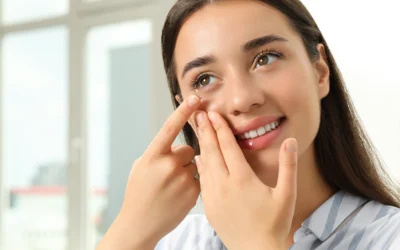The phrase “20/20 vision” has come to mean clear or perfect vision for many people. You’ve probably heard sayings like “hindsight is 20/20,” meaning we see things clearly when looking back on events. Or maybe a friend has told you they just had an eye exam and “have 20/20 vision,” proudly sharing that their eyesight is strong.
But what does it really mean to have 20/20 vision? And does having 20/20 vision truly mean your eyesight is “perfect”? Keep reading to find out the exact meaning and why people with 20/20 vision should still get comprehensive eye exams.
What is 20/20 vision?
The American Optometric Association (AOA) defines 20/20 vision as normal vision acuity (the clarity or sharpness of vision) measured at a distance of 20 feet. If you have 20/20 vision, you can see clearly at 20 feet what should normally be seen at a distance. If you have 20/100 vision, you must be as close as 20 feet to see what a person with normal vision can see at 100 feet.[1]
Is 20/20 vision considered perfect vision?
20/20 vision is not considered perfect vision. It is considered normal vision. If you have 20/20 vision, it means you can see clearly at 20 feet what should normally be seen at that distance. 20/20 vision does not account for other important visual skills, including peripheral vision, depth perception, eye coordination, the ability to see colors, and the ability to properly focus on objects.
Why do some people not have 20/20 vision?
People who have hyperopia (farsightedness), myopia (nearsightedness), astigmatism, or certain eye diseases can’t see clearly at 20 feet what should normally be seen at that distance. During a comprehensive eye exam at Walter Eye Clinic, we measure visual acuity. If we determine you cannot see clearly at 20 feet what should normally be seen at that distance, we will prescribe the appropriate treatment to help you achieve normal visual acuity.
If your vision isn’t 20/20, the treatment will depend on the underlying cause:
-
Refractive errors: If you are farsighted, nearsighted, or have astigmatism, a prescription for eyeglasses or contact lenses can often correct your vision to 20/20.
-
Eye disease or health-related issues: If your vision loss is caused by an eye disease, our eye doctor may prescribe medication or develop a customized treatment plan tailored to your specific eye health needs.
Do people with 20/20 vision need glasses?
Most people who have 20/20 vision will not need to wear eyeglasses until around the age of 40 or so, when vision starts to worsen when looking at things close-up. As we age, the lenses in our eyes gradually harden and lose flexibility (a condition known as presbyopia), making it more difficult to focus on nearby objects. Even if distance vision remains 20/20, many people over 40 notice blurry near vision and may benefit from reading glasses or glasses with progressive lenses to see clearly at all distances.
Another scenario in which a person with 20/20 vision will wear eyeglasses is if they work in front of a computer all day and want to wear blue light blocking lenses. Alternatively, if their eyes are out of alignment, they may need special lenses to help their eyes focus properly. These lenses eliminate painful side effects such as headaches, neck and shoulder pain, and eye fatigue.
If I have 20/20 vision, do I still need an eye exam?
If it’s been more than a year or two since your last eye exam, you may be surprised to learn that your vision has changed. Even if your last eye exam determined you have 20/20 vision and you feel that you can see fine, comprehensive eye exams are about more than your visual acuity. We fully examine your eye health, too, and can spot signs of diabetes, high blood pressure, and more, of which you may not even be aware. [1] The AOA (American Optometric Association)
Don’t put off scheduling your eye exams. Give us a call today or book an appointment online at Walter Eye Clinic in Tinley Park.



